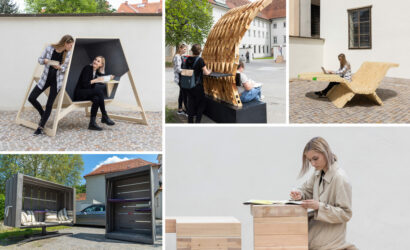
Ecoworld LCL GmbH develops and builds LED lighting fixtures. This also includes street and industrial lighting, which is gradually being changed to LED. On behalf of Ecoworld LCL GmbH, Creative Industries Styria has published an invited competition with the aim of developing a Graz-related streetlight that can be produced in Styria and sold worldwide. Hence, the company that is using design as a decisive competitive instrument is expanding its product range by a product suitable for mass-production.
Showcase 2018, an exhibition at designforum Steiermark, showed off all design drafts along with other Design Transfer projects.
The outline of the design of Pik As is created by the modular structure of the luminaire and the cooling fins which also serve as bird control. The central core containing the power supply unit can be mounted on masts. Plug&Play modules covering a power range of approx. 32 to 160 watts are added symmetrically on both sides, depending on the total output requested. Hence, a few components cover all urban applications. The cooling fins guarantee an efficient operation of the LED boards, whose pointed shape prevents birds from nesting and thus increases the device’s operating time.
The first draft by Thomas Feichtner is inspired by two features forming the identity of Graz: the iconographic architecture of the Kunsthaus Graz and that of the clock tower. Just as the light shafts in the Kunsthaus capture the light from above, the individual LED elements on the luminaire direct their light at different angles, which enables a very thin lamppost and an individual and effective use of the lighting source. The second concept is based on the idea of a gallery spotlight turning the whole city into a design gallery. The spots are shaped like a sloping roof, inspired by the silhouette of the Graz clock tower.
GEORG WANKER Industrial Design
Georg Wanker’s design concept focuses on practical function and technical simplicity. The designer aimed at developing a street lamp for everyday use that could be produced at low-cost by using modern technology and current production methods. Designed as a whip-type lamp, it completely foregoes a joint for adjusting the beam angle but uses a ‘bending area’ instead that is shaped with the main frame. The beam angle needs to be adjusted only once during assembly and remains in this position further on. The resulting product is a timeless luminaire lighting streets for another 30 years.
The series of luminaires called WING by Graz designer Johannes Scherr is inspired by the ‘Graz School’ of architecture. The basic design of the luminaire is particularly inspired by the striking, pointed canopy roof of the Graz Stadthalle, designed by architect Klaus Kada. Another crucial aspect defining the concept was a simple manufacturing process and high flexibility for different dimensions of the luminaires. While the external shape of the luminaire consists of a strip of thin aluminum plates, the visually striking, ribbed inner shape made of extruded aluminum also serves as a heat sink. One or more luminaires are asymmetrically positioned on the pole.

























